1:30min

–
As one of three Optometry Australia members awarded the LOOK International scholarship in 2024, Lily Ho had the opportunity to travel to the United States to study optometric advancements in eye care not yet readily available in Australia.
In this article, she shares insights from her trip, from observing collaborative care models between optometrists and ophthalmologists, to shadowing optometrists performing laser and minor surgical procedures.

As an Australian optometrist, I recently had the opportunity to visit the United States, where I learned about optometric practices that differ significantly from those in Australia. I travelled to Oklahoma, a state where optometrists can perform certain laser and minor surgical procedures. These are traditionally performed by ophthalmologists in Australia. This experience offered me a unique perspective on how optometry is evolving in different parts of the world. I am excited to bring this insight back to Australia and contribute to advocacy for the future of optometry in Australia
In Australia, the scope of optometric practice is well-defined, with optometrists primarily focusing on eye examination, vision correction, and the diagnosis and management of various eye conditions. More invasive procedures, such as laser treatments and surgeries, however, remain within the domain of ophthalmologists. Nevertheless, my time in Oklahoma allowed me to observe a model where optometrists and ophthalmologists collaborate much more closely, with optometrists taking on some additional responsibilities.

–
While shadowing optometrists at the College of Optometry at Northeastern State University in Oklahoma, I was able to observe them perform laser procedures including YAG capsulotomies, selective laser trabeculoplasty and laser peripheral iridotomies. Some anterior eye surgical procedures were also performed such as collagen cross-linking, lesion removals and Chalazion management. I also had the opportunity to shadow optometrists at Oklahoma Medical Eye Group and observed how optometrists worked closely alongside ophthalmologists. It was evident that these optometrists were highly trained and worked within a well-regulated, structured framework to ensure patient safety. There is a strong focus on collaboration to ensure patients received comprehensive, efficient and safe care.

–
This experience highlighted a range of benefits that could be realised in Australia, if optometrists’ scope was expanded in a way that complements the existing healthcare system. By working together, optometrists and ophthalmologists in Oklahoma have created a model that improves access to care for patients. While the benefits were most apparent in areas where ophthalmologists may not be readily available, notable advantages were also observed in urban settings. It’s a model based on trust, mutual respect, and a shared commitment to maximise patient outcomes.
As I return to Australia, I am inspired by the possibilities for our profession. While the integration of such practices here will require careful consideration and collaboration with our ophthalmology colleagues, I believe we can continue to advance eye care in ways that benefits all patients. This include building a closer collaborative care model with ophthalmologists and future-proofing our students for the evolving demands of the profession. My experience in Oklahoma has reinforced the importance of ongoing professional development and the value of exploring progressive approaches to care, to prioritise the patient’s well-being.–

–
I would like to especially thank Professor Nate Lighthizer and his team from College of Optometry at Northeastern State University; as well as Dr Jason Ellen and his staff from the Oklahoma Medical Eye Group, for sharing their experiences and making this such a wonderful opportunity. I am thankful to Optometry Australia for supporting the LOOK scholarship and I am excited by the opportunity to use this experience to help promote and assist with the improved utilisation of optometrists within the Australian workforce in eye care.
Lily will present the full insights and learnings from her trip in an article scheduled for publication in an upcoming issue of Optometry Connection.